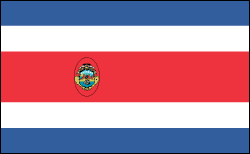Costa Rica is considered the "Switzerland of Central America." Costa Rica is stable, peaceful & democratic. Costa Rica is one of the 22 oldest democracies and abolished its army in 1949, funneling money normally spent on defense into education.

“Peace is not the product of a victory or a command. It has no finishing line, no final deadline, no fixed definition of achievement. Peace is a never ending process, the work of many decisions.”
H. E. Oscar Arias - former President of Costa Rica
Nobel Peace Laureate (1987)
Freedom & Democracy
Freedom: in Costa Rica we are free to choose how we want to live, what we want to work as and where we want to visit within our country.
Democracy: a true and strong democaracy where people have the right to vote directly for our leader. Independent parties have a chance.
The Republic of Costa Rica is a multi-party democratic republic with one of the most stable governments in the world, earning it the nickname “the Switzerland of Central America.”
Costa Rica is the most democratic country in Central America. Practicing the principals of democracy, Costa Ricans have enjoyed a peaceful country and stable government for the greater part of 117 years. Having survived a very brief civil war in 1948, the country has demonstrated an uninterrupted democratic process and continues to be a strong republic.
As in the United States, the government consists of three separate branches: executive, legislative and judicial.
The executive branch includes 2 vice presidents and the cabinet ministers who are appointed by the President. Presidential terms are 4 years and while the President may serve more than one term, they may not be consecutive. The President must have been out of office for at least 2 terms before running again.The current president is Laura Chinchilla, Costa Rica’s first female president.
The legislative branch consists of 57 elected members of the National Assembly. Each member is elected for one 4 year term. Following the completion of their term, they may run for office again once they have been out of office for a full term.
The judicial branch of government consists of 3 levels of courts- district, appellate & supreme. The Supreme Court has 4 chambers- commercial & civil, administrative & labor, criminal and constitutional. The judiciary is independent of the legislature and the executive.
In addition to the three branches, Costa Rica has what some consider to be a "fourth" branch of government – the Supreme Tribunal of Elections – an independent body with far-reaching powers that has the authority to organize and supervise National Elections.
Also similar to the US, all Costa Ricans are guaranteed equality before the law with basic rights such as freedom of speech, the right to petition and assembly, the right to own property, and the right to habeas corpus. All citizens enjoy the right to vote, starting at the age of 18, when they are automatically registered and issued a voter identity card. With the exception of the right to vote, all foreigners living in Costa Rica enjoy all the freedoms guaranteed under the Constitution.
The legal system in Costa Rica is based on the French Civil (Napoleonic) Code.
There are 7 provinces in Costa Rica - San Jose, Alajuela, Puntarenas , Guanacaste, Cartago, Heredia & Limon. There is no provincial legislature but each province has an elected mayor. Provinces are further broken down into municipalities.
As of the beginning of 2009, CAFTA-DR entered into force in Costa Rica, opening up trade with the U.S., the rest of Central America & the Dominican Republic.
Costa Rica is an active member of both the United Nations & the Organization of American States. Both the United Nations University of Peace and the Inter-American Court of Human Rights are based in Costa Rica.
“Well, Costa Rica is a proud example of a free people practicing the principals of democracy. And (they) have done so in good times and in bad, when it was easier and required great courage.”
Ronald Reagan – former President, United States
February 7, 2010 - F irst female president of Costa Rica
Laura Chinchilla Miranda
Laura Chinchilla Miranda, Georgetown University graduate is elected as the first female president of Costa Rica. Chinchilla was one of two former vice presidents to serve under President Óscar Arias during his second term who served as president o Costa Rica from 2006-2010. She resigned from her position as vice president in 2008 to begin campaigning for her own presidency.
Chinchilla won the election with a surprising 46.76% of the vote in the general elections held on February 7, 2010. This victory is a big win for the National Liberation Party (LPN) (green & white). Ottón Solís of the Citizens Action Party (PAC) came in a distant second with 25.16% of the vote.
At 50 years of age Laura Chinchilla will be the first female President of Costa Rica promoting her motto of “Progressive politics for a better world”.
Former president of Costa Rica
“I think it is appropriate that the first speech by any United States president to any student audience in Latin America should take place at this center of learning in a nation so dedicated to democracy,”
“We also want to express our thanks to the people of Costa Rica, Every one of us will go home with a most profound impression of what a strong, vital people can accomplish."
“This journey to Costa Rica has illuminated the minds of 180 million people [in the United States] of what a great opportunity and privilege we have to be associated together in our common cause.
“Viva Costa Rica, arriba Costa Rica, y muchas gracias.”
1963 - John F Kennedy, former president of the United States